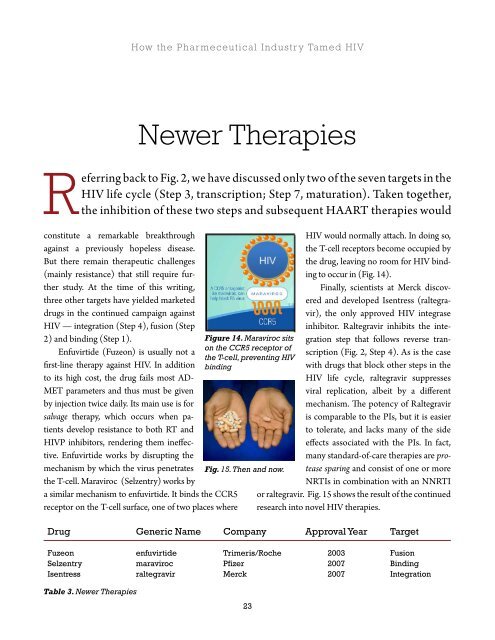Josh Bloom, Ph.D. - American Council on Science and Health
Josh Bloom, Ph.D. - American Council on Science and Health
Josh Bloom, Ph.D. - American Council on Science and Health
You also want an ePaper? Increase the reach of your titles
YUMPU automatically turns print PDFs into web optimized ePapers that Google loves.
c<strong>on</strong>stitute a remarkable breakthrough<br />
against a previously hopeless disease.<br />
But there remain therapeutic challenges<br />
(mainly resistance) that still require further<br />
study. At the time of this writing,<br />
three other targets have yielded marketed<br />
drugs in the c<strong>on</strong>tinued campaign against<br />
HIV � integrati<strong>on</strong> (Step 4), fusi<strong>on</strong> (Step<br />
2) <strong>and</strong> binding (Step 1).<br />
Enfuvirtide (Fuze<strong>on</strong>) is usually not a<br />
�rst-line therapy against HIV. In additi<strong>on</strong><br />
to its high cost, the drug fails most AD-<br />
MET parameters <strong>and</strong> thus must be given<br />
by injecti<strong>on</strong> twice daily. Its main use is for<br />
salvage therapy, which occurs when patients<br />
develop resistance to both RT <strong>and</strong><br />
HIVP inhibitors, rendering them ine�ective.<br />
Enfuvirtide works by disrupting the<br />
mechanism by which the virus penetrates<br />
the T-cell. Maraviroc (Selzentry) works by<br />
How the <str<strong>on</strong>g>Ph</str<strong>on</strong>g>armeceutical Industry Tamed HIV<br />
Newer Therapies<br />
Referring back to Fig. 2, we have discussed <strong>on</strong>ly two of the seven targets in the<br />
HIV life cycle (Step 3, transcripti<strong>on</strong>; Step 7, maturati<strong>on</strong>). Taken together,<br />
the inhibiti<strong>on</strong> of these two steps <strong>and</strong> subsequent HAART therapies would<br />
a similar mechanism to enfuvirtide. It binds the CCR5<br />
receptor <strong>on</strong> the T-cell surface, <strong>on</strong>e of two places where<br />
Figure 14. Maraviroc sits<br />
<strong>on</strong> the CCR5 receptor of<br />
the T-cell, preventing HIV<br />
binding<br />
Fig. 15. Then <strong>and</strong> now.<br />
23<br />
HIV would normally a�ach. In doing so,<br />
the T-cell receptors become occupied by<br />
the drug, leaving no room for HIV binding<br />
to occur in (Fig. 14).<br />
Finally, scientists at Merck discovered<br />
<strong>and</strong> developed Isentress (raltegravir),<br />
the <strong>on</strong>ly approved HIV integrase<br />
inhibitor. Raltegravir inhibits the integrati<strong>on</strong><br />
step that follows reverse transcripti<strong>on</strong><br />
(Fig. 2, Step 4). As is the case<br />
with drugs that block other steps in the<br />
HIV life cycle, raltegravir suppresses<br />
viral replicati<strong>on</strong>, albeit by a di�erent<br />
mechanism. �e potency of Raltegravir<br />
is comparable to the PIs, but it is easier<br />
to tolerate, <strong>and</strong> lacks many of the side<br />
e�ects associated with the PIs. In fact,<br />
many st<strong>and</strong>ard-of-care therapies are protease<br />
sparing <strong>and</strong> c<strong>on</strong>sist of <strong>on</strong>e or more<br />
NRTIs in combinati<strong>on</strong> with an NNRTI<br />
or raltegravir. Fig. 15 shows the result of the c<strong>on</strong>tinued<br />
research into novel HIV therapies.<br />
Drug Generic Name Company Approval Year Target<br />
Fuze<strong>on</strong> enfuvirtide Trimeris/Roche 2003 Fusi<strong>on</strong><br />
Selzentry maraviroc Pfizer 2007 Binding<br />
Isentress raltegravir Merck 2007 Integrati<strong>on</strong><br />
Table 3. Newer Therapies










